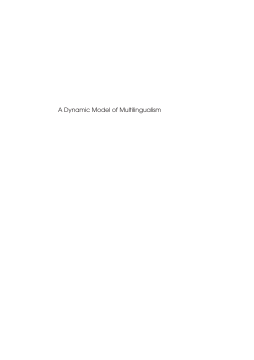
Additional Information
Book Details
Abstract
The model presented in this volume draws together various strands of research – second language acquisition theory, bilingualism research, dynamic systems theory – to develop a novel approach to this challenging subject. Its main focus lies on the psycholinguistic dynamics of multilingualism, the processes of change in time affecting two or more language systems.
The DMM does offer a new and intriguing metaphor for applied linguistic research. It adopts the kind of holistic approach needed to describe the extreme complexity of diachronic and synchronic variation in language systems.
Jean-Marc Dewaele
Philip Herdina has published on the methodology of linguistics and literature, theory of grammar and multilingualism. He is also the co-author of a bilingual philosophical dictionary.
Ulrike Jessner has published on psycholinguistic issues in the fields of second language acquisition, multilingualism and gender issues. Recently she has co-edited the book English in Europe (Multilingual Matters, 2000).
Both authors are Associate Professors of English Linguistics at the University of Innsbruck, Austria.
I strongly recommend this stimulating monograph to anyone working on bi-/multilingualism or second/third language acquisition.
Michael Clyne
There is no doubt that Herdina and Jessner’s Dynamic Model of Multilingualism provides a significant and welcome contribution to theoretical development in language acquisition and multilingualism. This volume deserves a close reading and should become a reference in discussions of multilingualism.
Guillaume Gentil
This book sets out with the highly ambitious aim of combining two fields of investigation which are not self-evidently relatable - namely, on the one hand, research into dynamic systems and, on the other, research into multilingualism. It seeks to use notions of dynamic systems as they have been applied in such areas as physics and meteorology as the basis for the development of a dynamic model of multilingualism. The writing is clear and the argumentation cogent throughout, and although the text is certainly not an easy read, its insightfulness fully repays the close attention it demands. There is absolutely no doubt that this volume will quickly become - and will deserve to become - an indispensable reference-point in any discussion of multilingualism.
David Singleton, Associate Professor of Applied Linguistics, Trinity College, Dublin, Ireland.
The authors take up the courage to break with conventional language acquisition theory and provide a new, dynamic view of language processing where language maintenance and language loss are seen as determining factors in multilingual competence. The novelty and special value of the book is that it pioneers the way to learning more about the differences between bilingualism and trilingualism. This is an innovative book with a detailed description of a new approach offered in multilingualism studies. The book is well written, logically structured and is a useful piece of work for scholars ready for new waves in research and eager to explore and understand as much as possible about multilingualism.
Judit Navracsics
A Dynamic Model of Multilingualism is an innovative, challenging and stimulating book about multilingual development... It will provide an invaluable conception and metaphor that can assist in reinterpreting research findings, recognising their limitations and placing them in relation to other variables and within the broad context of dynamic multilingualism. I recommend the book to researchers, advance graduate students, educators and language planners interested in psychological issues of multilingualism and second language acquisition as well as language maintenance and loss.
Peter Ecke
I found the book very stimulating, introducing an approach and a model which have the prospect of setting a new course towards a better understanding of language acquisition in general and multilingualism in particular. The most significant contribution of the book, it appears to me, is that it attempts to provide a theoretical basis for multilingualism in its own right, independently of any monolingual norms.
Masayo Yamamoto
“… the book is certainly worth reading”.
Elizabeth Hiser
Multilingual education represents the future and this volume will certainly help the reader understand it better. I strongly believe it will be widely cited in future.
David Lasagabaster
Table of Contents
| Section Title | Page | Action | Price |
|---|---|---|---|
| Contents | v | ||
| Preface | vii | ||
| List of Figures | ix | ||
| List of Acronyms | x | ||
| Chapter 1 Introductory Remarks | 1 | ||
| Chapter 2 Stages in Research on Multilingualism | 6 | ||
| Chapter 3 Transfer Reconsidered | 19 | ||
| Chapter 4 Universal Grammar Reviewed | 30 | ||
| Chapter 5 Multilingual Proficiency Reassessed | 52 | ||
| Chapter 6 A Dynamic Model of Multilingualism Developed | 76 | ||
| Chapter 7 A Dynamic Model of Multilingualism Analysed | 111 | ||
| Chapter 8 Holism Defended: A Systems Interpretation | 144 | ||
| Chapter 9 Limitations, Conclusions and Outlook | 153 | ||
| References | 162 | ||
| Index | 180 |
